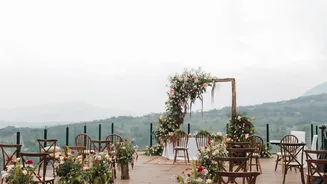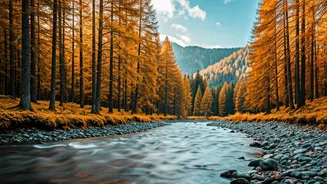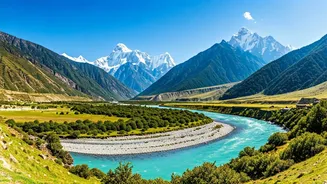For many Indian travellers who grew up in the era of packed sightseeing schedules and plastic-wrapped soaps, hotels were never the point. They were just
a place to crash after long days of temple hopping and city tours, lucky if they had a decent breakfast buffet or cable TV that actually worked. Comfort meant convenience only. Rest was for the wicked. But that’s changed. Somewhere between growing up and burning out, they’ve begun to travel differently, seeking stays that slow them down rather than push them out. In Coorg, it might mean spending a morning at your coffee plantation stay instead of ticking off waterfalls. In the Andamans, it’s lingering on your seaside porch rather than the beach. In Jaisalmer, it’s sipping chai in a sandstone courtyard long after the city outside has gone to sleep. The hotel can actually be an extension of the destination you’re visiting, and if you pick well, a worthy competitor. According to Booking.com’s How India Travels 2025 report, and Skyscanner’s trend release, travellers are increasingly checking in not just to explore cities, but to explore the hotels themselves. The stay has become the story. Resorts are now hosting everything from forest meditation and chef-led foraging walks to poetry readings and stargazing nights. It is no wonder then, that hotels in India too have taken up the challenge, ensuring their wonders go beyond a crisp white sheet and fluffy pillows at night. While weddings remain central to hotel economics, non-traditional events are rising—book readings, art pop-ups, spiritual workshops, and startup offsites that feel like retreats, as per Booking.com's report. In premium segments, non-room revenue, especially from F&B and events, now accounts for about 50% of income. Travellers increasingly look beyond major chains to boutique hotels, homestays, and unique stays. This shift signals that alternative formats are no longer fringe options but core to how accommodation is delivered and consumed in India. And the numbers back it up: Budget hotels and economy chains (34%) are now the top choice for leisure travellers, followed by branded hotel chains (27%). Boutique hotels, heritage stays, and homestays each hold about 9% of the market, with luxury resorts and spa retreats close behind at 8%. In short, Indians aren’t just travelling more but actually experimenting more and spending differently.
The New Pace Of Travel
The pandemic taught us to slow down, and it’s a lesson that stuck. People no longer want a holiday that feels like a race. In fact, if you drive into voco Jim Corbett, you’ll hear the forest long before you see it. The air smells of river water, and life moves at half its usual speed. “Travellers today are looking for more immersive experiences without having to step outside the resort,” says Suprabhath Roy Chowdhury, General Manager at the property. “Guests want to slow down, reconnect with nature, and make the most of the destination from within the property itself.”So they’ve created a rhythm that mirrors the forest beyond: Hi-Tea with evening Aarti at the Kosi Deck, stargazing sessions by the river, yoga at sunrise, and even private BBQ dinners under the stars. Families with kids can book mini night-camping experiences in mango orchards, complete with marshmallows and hot chocolate, all within the safe comfort of the resort. “Every corner reflects the spirit of Corbett - serene, natural, and rejuvenating,” he adds.
Skip The Schedules
India’s ‘Resort-First’ movement is also influencing how properties now approach tourists. Hotels are now designing experiences that unfold organically through the day rather than being jammed into itineraries. At Amaraanth Goa, for example, “every space has been designed with the guest journey at its heart, from sunrise yoga and reflexology walks to cocktails at The Lab and open-air cinema nights under the stars,” says founder Shradha Binani. “The intention was to create a natural flow through the day, where experiences reveal themselves gently, without any need to plan. It’s intuitive luxury–moments that feel effortless, personal, and organically woven into the rhythm of the stay.”This unhurried design is actually part of a cultural shift that no longer wants to see Goa as just a party destination. Sure, we don’t mind a drink, but gone are the day of bottomless sangrias. “We’ve redefined the idea of a Goan getaway,” she explains, “from being purely about beaches and nightlife to one that celebrates art, nature, and slow living.”
Hotels As Microcosms Of Place
This new generation of hotels no longer wants travellers to drop their bags at check in and head out. They want them to also immerse themselves into a space that is designed for them. CGH Earth, a pioneer in community-based hospitality, believes the resort and its surroundings are inseparable. “The hotel serves as a portal to the village and community around it,” says Mridula Jose, VP-Marketing.“Members of the local community play an active role in curating experiences both within and beyond the property.” If you go to one of their properties, like Tilar Siro in Andaman, you will learn to take sea walks with locals, or in Thekkady, get a cooking lesson from a local chef. Sometimes, artisans work right in the hotel courtyard!
“Many of these community members are also part of our team,” she adds. “Our experiences naturally extend beyond the resort, involving community-based activities that are integral to our philosophy of responsible and inclusive tourism.”
It’s a subtle but important distinction. The “resort-first” movement isn’t about never leaving the gate; it’s about ensuring the spirit of the destination flows through it.
Gen Z Is Staying In (And Posting It)
It’s not just older travellers embracing the slower life. Gen Z and younger millennials are powering this shift too, and actually changing what “luxury” means. A 2025 Booking.com survey found that 93 percent of Gen Z and Gen Alpha influence family travel decisions in India, often choosing properties that look good on social media and deliver authentic experiences.At Amaraanth, this means details like a boutique showcasing local textiles and crafts, sound-healing sessions, and cocktails made from regional ingredients. All of these are deeply experiential yet highly shareable. “Travellers now see hotels as places for both rest and inspiration,” Shradha explains. “The lines between leisure and living have blurred.”
A Sense Of Belonging, Not Just A Bed
What makes these properties stand out is the way they create a feeling of belonging, a kind of pop-up community. At voco Jim Corbett, guests gather for evening Aarti on the Kosi Deck, live music, and Kumaoni dance performances by local artists. “We call it the voco life,” Suprabhath says. “These moments encourage guests to engage, share stories, and feel part of something more than just a stay.”Maybe my parents won’t get it. To them, a hotel will always be a place to sleep between temple visits and taxi rides. But for my generation, travel feels different. The ‘where’ is certainly a good story, but if the ‘how’ helps me unwind and take a beat from office deadlines, I don’t mind travelling to maybe just eat, sleep and repeat.















